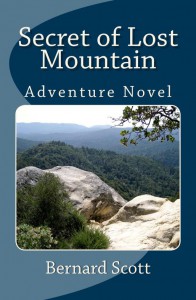
Literary critics, the world over, write critiques and reviews of novels every day. Catholic novels are something different or we wouldn’t label them “Catholic.” We can suppose that such novels contain our particular set of beliefs and practices and we know that all Catholic novels teach some kind of lesson.
Want proof?
Read Bernard Scott’s first novel, “The Secret of Lost Mountain” — it comes with an instructor’s manual.
His story concerns a traveler who, led by an account of an old Jesuit priest, searches for a rumored tribe of primitives. The book is illustrated, something we rarely see nowadays. The traveler arrives at a faraway island by a rusty, old steamer, dressed in a typical explorer outfit — high boots, peasant shirt, vest, pants tucked, all circa early 20th century. We discover that this traveler is also an explorer, anthropologist, and linguist.
A boy named Carlito befriends him so we note the Spanish influence. But the rest of the cast members are from a tribe called the Chiroki. The illustrations clearly show a Mayan or Aztec-type dress so we can place the location on an island somewhere near Central or South America.
The instructor’s manual refers to the story as an allegory. Perhaps its allegorical meaning is in the silent tribe, either as a representation of marginalized peoples or related to a modern problem like immigration.
The explorer, never named, is a man of science and an agnostic. He talks with a Chiroki man related to the chief and journeys up the river, ala Joseph Conrad’s “Heart of Darkness.”
The Chiroki man gives the explorer a small satchel, which contains a relic of St. Odilia, the patron saint of good eyesight. The Jesuit who met the tribe decades prior left such an impression that the chief thinks the explorer is also a priest at first.
The irony of the chief mistaking an agnostic for a priest should not be lost on us. The Chiroki give the now-ersatz priest vestments left by the Jesuit and they ask him to perform something that alludes to the Mass. The explorer tries to mimic rituals that he’d witnessed in his life, for example, the elevation of the Host.
Finally, the explorer learns about Lost Mountain, what it means to the Chiroki and what happens there. The Chiroki believe that the mountain is cursed and they take all of their children born deaf, dumb and blind and leave them there. Somehow, inexplicably, another tribe has formed called the Jakareme, or “children of the curse.”
The explorer discovers these physical challenges among the Jakareme and sets out to find a way to communicate with them.
Here, the explorer learns the depth of the human spirit. Despite impossible odds, the people are still able to feed themselves, build shelters, teach their young, and develop a social order similar to that of the originating Chiroki. Men and women live in separate camps and they split the division of labor along gender lines.
The intricacies of the non-verbal language developed by the people who are deaf, dumb, and blind is exceedingly interesting as only a linguist could construct it; a mystery in itself.
Once the explorer discovers the way in which the Jakareme communicate he suddenly desires to bring “the good news” that there is no curse and that he will be able to re-unite the two peoples.
When the Chiroki arrive to return the explorer to the river and home, he shows them “the way,” how the Jarkareme have survived and how they have flourished. He makes straight the way of re-unity.
After all of this, the explorer disappears from the book, allegorically ascending from sight. We might finally ask: is the explorer, the bringer of good news, who lowered himself to communicate with the cursed or sinful, the Christ-like figure?
An agnostic?
Ultimately, the novel is a unique, creative, and an interesting read for anyone wanting something different.
Available from https://www.logosinstitute.org/.






